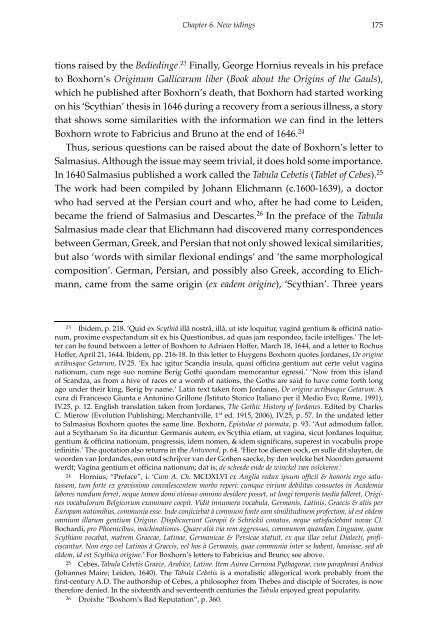historical and political thought in the seventeenth - RePub - Erasmus ...
historical and political thought in the seventeenth - RePub - Erasmus ...
historical and political thought in the seventeenth - RePub - Erasmus ...
Create successful ePaper yourself
Turn your PDF publications into a flip-book with our unique Google optimized e-Paper software.
Chapter 6. New tid<strong>in</strong>gs<br />
tions raised by <strong>the</strong> Bedied<strong>in</strong>ge. 23 F<strong>in</strong>ally, George Hornius reveals <strong>in</strong> his preface<br />
to Boxhorn’s Orig<strong>in</strong>um Gallicarum liber (Book about <strong>the</strong> Orig<strong>in</strong>s of <strong>the</strong> Gauls),<br />
which he published after Boxhorn’s death, that Boxhorn had started work<strong>in</strong>g<br />
on his ‘Scythian’ <strong>the</strong>sis <strong>in</strong> 1646 dur<strong>in</strong>g a recovery from a serious illness, a story<br />
that shows some similarities with <strong>the</strong> <strong>in</strong>formation we can f<strong>in</strong>d <strong>in</strong> <strong>the</strong> letters<br />
Boxhorn wrote to Fabricius <strong>and</strong> Bruno at <strong>the</strong> end of 1646. 24<br />
Thus, serious questions can be raised about <strong>the</strong> date of Boxhorn’s letter to<br />
Salmasius. Although <strong>the</strong> issue may seem trivial, it does hold some importance.<br />
In 1640 Salmasius published a work called <strong>the</strong> Tabula Cebetis (Tablet of Cebes). 25<br />
The work had been compiled by Johann Elichmann (c.1600-1639), a doctor<br />
who had served at <strong>the</strong> Persian court <strong>and</strong> who, after he had come to Leiden,<br />
became <strong>the</strong> friend of Salmasius <strong>and</strong> Descartes. 26 In <strong>the</strong> preface of <strong>the</strong> Tabula<br />
Salmasius made clear that Elichmann had discovered many correspondences<br />
between German, Greek, <strong>and</strong> Persian that not only showed lexical similarities,<br />
but also ‘words with similar flexional end<strong>in</strong>gs’ <strong>and</strong> ‘<strong>the</strong> same morphological<br />
composition’. German, Persian, <strong>and</strong> possibly also Greek, accord<strong>in</strong>g to Elichmann,<br />
came from <strong>the</strong> same orig<strong>in</strong> (ex eadem orig<strong>in</strong>e), ‘Scythian’. Three years<br />
23 Ibidem, p. 218. ‘Quid ex Scythiâ illâ nostrâ, illâ, ut iste loquitur, vag<strong>in</strong>â gentium & offic<strong>in</strong>â nationum,<br />
proxime exspect<strong>and</strong>um sit ex his Questionibus, ad quas jam respondeo, facile <strong>in</strong>telliges.’ The letter<br />
can be found between a letter of Boxhorn to Adriaen Hoffer, March 18, 1644, <strong>and</strong> a letter to Rochus<br />
Hoffer, April 21, 1644. Ibidem, pp. 216-18. In this letter to Huygens Boxhorn quotes Jordanes, De orig<strong>in</strong>e<br />
actibusque Getarum, IV.25. ‘Ex hac igitur Sc<strong>and</strong>ia <strong>in</strong>sula, quasi offic<strong>in</strong>a gentium aut certe velut vag<strong>in</strong>a<br />
nationum, cum rege suo nom<strong>in</strong>e Berig Gothi quondam memorantur egressi.’ ‘Now from this isl<strong>and</strong><br />
of Sc<strong>and</strong>za, as from a hive of races or a womb of nations, <strong>the</strong> Goths are said to have come forth long<br />
ago under <strong>the</strong>ir k<strong>in</strong>g, Berig by name.’ Lat<strong>in</strong> text taken from Jordanes, De orig<strong>in</strong>e actibusque Getarum. A<br />
cura di Francesco Giunta e Anton<strong>in</strong>o Grillone (Istituto Storico Italiano per il Medio Evo; Rome, 1991),<br />
IV.25, p. 12. English translation taken from Jordanes, The Gothic History of Jordanes. Edited by Charles<br />
C. Mierow (Evolution Publish<strong>in</strong>g; Merchantville, 1 st ed. 1915, 2006), IV.25, p. 57. In <strong>the</strong> undated letter<br />
to Salmasius Boxhorn quotes <strong>the</strong> same l<strong>in</strong>e. Boxhorn, Epistolae et poemata, p. 93. ‘Aut admodum fallor,<br />
aut a Scytharum Su ita dicuntur. Germanis autem, ex Scythia etiam, ut vag<strong>in</strong>a, sicut Jordanes loquitur,<br />
gentium & offic<strong>in</strong>a nationum, progressis, idem nomen, & idem significans, superest <strong>in</strong> vocabulis prope<br />
<strong>in</strong>f<strong>in</strong>itis.’ The quotation also returns <strong>in</strong> <strong>the</strong> Antwoord, p. 64. ‘Hier toe dienen oock, en sulle dit sluyten, de<br />
woorden van Jord<strong>and</strong>es, een outd schrijver van der Go<strong>the</strong>n saecke, by den welcke het Noorden genaemt<br />
werdt; Vag<strong>in</strong>a gentium et offic<strong>in</strong>a nationum; dat is; de scheede ende de w<strong>in</strong>ckel van volckeren.’<br />
24 Hornius, “Preface”, i. ‘Cum A. Ch. MCDXLVI ex Anglia redux ipsum officii & honoris ergo salutassem,<br />
tum forte ex gravissimo convalescentem morbo reperi: cumque virium debilitas consuetos <strong>in</strong> Academia<br />
labores nondum ferret, neque tamen domi otiosus omn<strong>in</strong>o desidere posset, ut longi temporis taedia falleret, Orig<strong>in</strong>es<br />
vocabulorum Belgicorum exam<strong>in</strong>are coepit. Vidit <strong>in</strong>numera vocabula, Germanis, Lat<strong>in</strong>is, Graecis & aliis per<br />
Europam nationibus, communia esse. Inde conjiciebat à communi fonte eam similitud<strong>in</strong>em profectam, id est eâdem<br />
omnium illarum gentium Orig<strong>in</strong>e. Displicuerunt Goropii & Schrickii conatus, neque satisfaciebant novae Cl.<br />
Bochardi, pro Phoenicibus, mach<strong>in</strong>ationes. Quare alia via rem aggressus, communem qu<strong>and</strong>am L<strong>in</strong>guam, quam<br />
Scythiam vocabat, matrem Graecae, Lat<strong>in</strong>ae, Germanicae & Persicae statuit, ex qua illae velut Dialecti, proficiscantur.<br />
Non ergo vel Lat<strong>in</strong>os à Graecis, vel hos à Germanis, quae communia <strong>in</strong>ter se habent, hausisse, sed ab<br />
eâdem, id est Scythica orig<strong>in</strong>e.’ For Boxhorn’s letters to Fabricius <strong>and</strong> Bruno, see above.<br />
25 Cebes, Tabula Cebetis Graece, Arabice, Lat<strong>in</strong>e. Item Aurea Carm<strong>in</strong>a Pythagorae, cum paraphrasi Arabica<br />
(Johannes Maire; Leiden, 1640). The Tabula Cebetis is a moralistic allegorical work probably from <strong>the</strong><br />
first-century A.D. The authorship of Cebes, a philosopher from Thebes <strong>and</strong> disciple of Socrates, is now<br />
<strong>the</strong>refore denied. In <strong>the</strong> sixteenth <strong>and</strong> <strong>seventeenth</strong> centuries <strong>the</strong> Tabula enjoyed great popularity.<br />
26 Droixhe “Boxhorn’s Bad Reputation”, p. 360.<br />
175

















